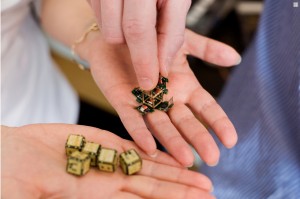Programmable 'smart sand' can assume any shape

Researchers at MIT have developed a robotic system for duplicating shapes that could someday allow spontaneous formation of new tools or replacements for broken objects.

'Smart pebbles' â?? cubes about 10 millimeters to an edge â?? with processors and magnets built in. Credit: M. Scott Brauer
The Distributed Robotics Laboratory (DRL) at MIT’s Computer Science and Artificial Intelligence Laboratory has detailed research into algorithms that could enable “smart sand.” These are self-sculpting reconfigurable robotic cubes that send messages among themselves to recreate a three-dimensional object.
Unlike 3-D printing techniques, which use an additive process, the smart sand approach aims to replicate objects by essentially carving them out of a larger heap of building blocks with only an original shape as a guide.
The algorithms work for 2-D (see video below) and 3-D objects, the researchers said.
For the 3-D research, the MIT team tested the algorithms on larger "pebbles" measuring about 10 millimeters across, or just under a half an inch, with rudimentary microprocessors inside and magnets on four sides, which is all they could accommodate. Computer simulations revealed that the algorithm would work with a 3-D block of cubes just as it did for 2-D objects.
There are engineering challenges to get the cubes down to a size akin to grains of sand and still function as expected, but the team said that the core functionality is in place.
Researchers envision the system used for rapid prototyping or reproducing broken objects, such as car parts that need replacing. “Say the tire rod in your car has sheared,” said Kyle Gilpin, co-author on the new paper. “You could duct tape it back together, put it into your system and get a new one.”
The team will present the research at the IEEE International Conference on Robotics and Automation next month.
Related:
3-D printer with nano-precision sets world record Autonomous swarming blocks basis for display concept Japanese mill carves perfect helmet from metal block